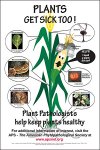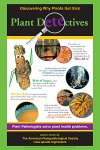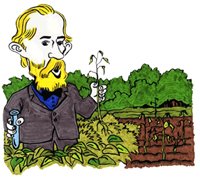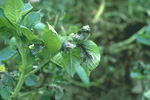Marie A. C. Langham,
South Dakota State University
Could you use posters about plant disease for your fourth graders? Or maybe you could use a brochure about careers in plant pathology for advising high school biology and agriculture students? How about an illustrated storybook describing the origin, relevance, and science of plant pathology that is available in English or Spanish? These and many other resources are available at the Plant Health Instructor website in the Education Center Resource Catalog where Dr. Michael A. Sulzinski (Senior Editor for the Resource Catalog) provides links to a variety of information sources related to Plant Pathology. This information is presented in a variety of formats and is available to fulfill many needs in the classroom.

Figure 1 |

Figure 2 |

Figure 3 |
In the Resource Center, you can access links to the posters "Plants Get Sick Too" and “Plant Detectives- Discovering Why Plants Get Sick” (Figures 1 and 2). These are available for downloading. Links are also provided to the storybook, “Plant Pathology: Past to Present” (Figure 3). The storybook describes the origin of plant pathology through the viewpoint of Anton DeBary, the scientist who founded plant pathology. It also discusses what plant pathology is and how plant pathology relates to today’s agriculture. The storybook is available in both English and Spanish (Note side box at end of the article.)
Another valuable resource available through the Education Center Resource Catalog is the recently updated “Careers in Plant Pathology,” a brochure provided by the APS Office of Public Affairs and Education on the types of careers available and the educational path suggested for students. It is also appropriate for providing students with a preliminary introduction to Plant Pathology.
Dr. Sulzinski provides a bibliography of articles, lessons, books, and videotapes that are about Plant Pathology and events where plant pathology has made an impact on our world, such as the Irish Potato Famine. Some examples of items referenced here include:
- A Special Issue On Global Movement Of Invasive Plants And Fungi by A. Y. Rossman [Bioscience 51(2):93-153]
- Plant Pathologists At The Center Of A Circus: A Devastating Oak Disease Has Reshaped Two Scientists' Careers by B. Shouse [Science 300:418-419 (April 18, 2003)]
- Plant Pathology Courses For Agricultural Awareness by G. Schumann and C. D’Arcy (Plant Disease 83:492-501)
- Magical Mushrooms, Mischievous Molds by G. Hudler. Princeton University Press; Princeton, NJ.
- Microbes and Man by J. Postgate. Cambridge University Press; Cambridge, U.K.
- Seeds for Tomorrow. Nova Program. Coronet Film and Video. 420 Academy Dr; Northbrook IL 60062.
- Dutch Elm Disease and the American Elm. Video by D. M. Eastburn, C.J. D’Arcy, and L. McKee. APS Press; St. Paul, MN.
Dr. Sulzinski also provides a strong listing of websites devoted to specific diseases, pathogens, or crops. These websites provide fast references for information on many topics in plant pathology.

Figure 4 |
In order to assist busy educators who may have difficulty finding a source for that special supply needed for a class project or experiment, Dr. Sulzinski provides a listing of microbe and laboratory supply sources. These suppliers provide many items that are useful in developing laboratory experiments and providing resources for science fair projects. An example of the resources available is “Phytophthora infestans, the Irish Potato Famine Pathogen Kit”, available from Carolina Biological Supply Company (Figure 4). This kit provides advanced high school students an opportunity to determine if samples contain Phytophthora infestans, the cause of late blight of potato, through the use of polymerase chain reaction (PCR).
The Education Center Resource Catalog has valuable materials that can easily be incorporated into teaching programs. These resources are appropriate for students and educators on many levels. Check out this catalog, and your students will benefit from this new information resource.
|
¡Atención Profesores de Español!
Would you like to have a cooperative unit with a fellow biology teacher? Try the storybook, “Plant Pathology: Past to Present”. The storybook is available in both Spanish and English. It will provide the opportunity to discuss many scientific terms and other terms, such as infection, disease, plant, and leaves, that are important in speaking languages, but may not appear in typical textbook dialogues. It will also aid in developing an understanding that science is a discipline that reaches across many border and cultures for the benefit of all mankind. Watch for other Spanish publications from APS as they become available for use, including Spanish versions of some of the APS Press publications. |
